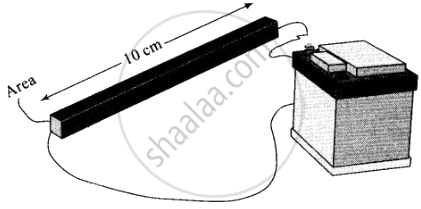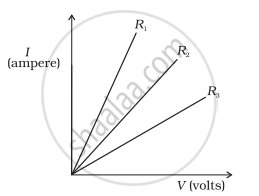Advertisements
Advertisements
प्रश्न
A metal rod of length 10 cm and a rectangular cross-section of 1 cm × `1/2` cm is connected to a battery across opposite faces. The resistance will be ______.
पर्याय
maximum when the battery is connected across 1 cm × `1/2` cm faces.
maximum when the battery is connected across 10 cm × `1/2` cm faces.
maximum when the battery is connected across 10 cm × `1/2` cm faces.
same irrespective of the three faces.
उत्तर
A metal rod of length 10 cm and a rectangular cross-section of 1 cm × `1/2` cm is connected to a battery across opposite faces. The resistance will be maximum when the battery is connected across 1 cm × `1/2` cm faces.
Explanation:
The resistance of a wire depends on various parameters, its area, material (resistivity) and length (length of the rod).
Here, the metallic rod behaves as a wire.
The relationship between resistance and various parameter is given by R = ρl/A.

The resistance of a wire is given by R = `p l/A`
For greater value of R, l must be higher and A should be lower and it is possible only when the battery is connected across 1 cm × `(1/2)` cm (area of corss-section A).
APPEARS IN
संबंधित प्रश्न
Will current flow more easily through a thick wire or a thin wire of the same material, when connected to the same source? Why?
An electric bulb draws 1.2 A current at 6.0 V. Find the resistance of filament of bulb while glowing.
In the circuit shown below in Fig, calculate the value of x if the equivalent resistance between A and B is 4 Ω.

State microscopic form of Ohm’s law.
The unit of specific resistance is ____________.
A student carries out an experiment and plots the V-I graph of three samples of nichrome wire with resistances R1, R2 and R3 respectively. Which of the following is hue?

A student carries out an experiment and plots the V-I graph of three samples of nichrome wire with resistances R1, R2 and R3 respectively. Which of the following is true?


Calculate the total resistance of the circuit and find the total current in the circuit.
Let the resistance of an electrical device remain constant, while the potential difference across its two ends decreases to one fourth of its initial value. What change will occur in the current through it? State the law which helps us in solving the above stated question.
The voltage - current readings of a certain material are shown in the table given below:
| Voltage (V) | 10 V | 20 V | 30 V |
| Current (I) | 2 A | 3 A | 4 A |
Study the table.
- State whether the conductor used is ohmic or non-ohmic.
- Justify your answer.
- State Ohm's law.
